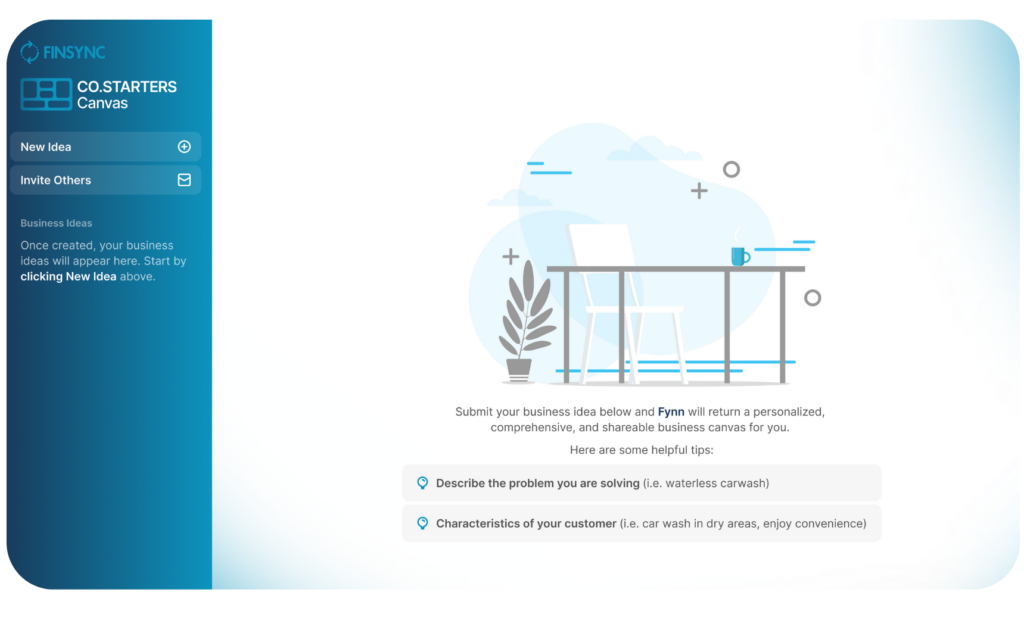Every business begins with a vision, but transforming that idea into a structured plan is where it truly takes shape. A business plan is your compass, ushering your vision toward success by defining your goals, sharpening your ideas, and preparing you to navigate the challenges ahead. With this guide, you will create a business plan that is straightforward, actionable, and tailored to your venture.
Here are ten actionable steps to bring sharp focus and clear direction to your business journey.
1. Recognize Your Customer
The foundation of your business plan lies in identifying your customers. These are the people you aim to serve, and a deep understanding of them will profoundly shape every decision you make. FINSYNC’s AI Assistant Fynn helps you dig deeper into these insights by turning customer data into action and aligning your strategy with their needs.
Think about their demographics. How old are they? Where do they live? What do they value? What are their interests? Understanding your customers’ habits, motivations, and needs will help you craft a product or service that resonates with them.
For example, if you plan to open a coffee shop, your customers might include young professionals looking for a quiet place to work or socialize. The more specific you can be, the more tailored your plan will be.
2. Identify the Problem
Every business exists to address a specific challenge. To connect with your customers, you need to pinpoint the issues they face, the frustrations, unmet needs, or gaps in the market that your business can fill.
Ask yourself: What obstacles are your customers encountering? What problems disrupt their day or limit their options?
Using the coffee shop example, the challenge might be a lack of a cozy, welcoming space where people in your area can relax, meet others, or work efficiently outside their homes. Defining this challenge gives your business purpose and provides the foundation for your strategy. Understanding the specifics of what your customers need ensures you are solving a real, meaningful problem.
3. Present a Solution
Once you have identified the challenge, shift your focus to how your business will solve it. This is where you outline your product or service’s value and what makes your approach unique.
Showcase how your coffee shop will stand apart and deliver real value. This could include offering high-quality, ethically sourced coffee, locally baked pastries, and a space thoughtfully designed with comfortable seating, natural lighting, and a welcoming atmosphere. Create an environment that offers a coworking space, hosting community events, or offering eco-friendly packaging.
Your solution should demonstrate how you will address customer needs in a practical and appealing way, setting the stage for your business to thrive. By presenting a clear and compelling solution, you position your business as the answer to your customers’ challenges.
4. Highlight the Benefits
The impact of your product or service goes beyond solving a problem, it is about the lasting value it creates for your customers. Think about how your business improves their day-to-day lives or brings unique advantages they cannot find elsewhere.
The coffee shop benefits might include creating a warm, inviting atmosphere where customers feel encouraged to linger. Whether it is professionals seeking a relaxed workspace, friends catching up over coffee, or strangers connecting through shared experiences, your space becomes a hub for meaningful interactions. By offering high-quality beverages and a comfortable environment designed for conversation and collaboration, you foster a sense of community that makes your brand unforgettable.
Focus on the results your customers will see or feel, such as improved productivity, a sense of belonging, or small indulgences that brighten their day. By showcasing your business’s benefits, you strengthen your brand’s value and deepen your connection with your audience.
5. Explore Alternatives
Your customers already have options. Understanding these alternatives is essential to positioning your business. To uncover where your opportunities lie, research your competitors and evaluate the existing solutions your customers might choose.
Here are some steps to guide your market research:
• Identify the Competition: Create a list of direct competitors offering similar products or services. For a coffee shop, this might include other cafés, bakeries, or even convenience stores with grab-and-go coffee options.
• Assess their Strengths and Weaknesses: Visit competitor locations or review their online presence. Pay attention to product quality, customer service, ambiance, and pricing.
• Analyze their Branding: Study how they market themselves. Look at their messaging, logo, website design, and social media engagement. Determine what appeals to their audience and what could be improved. Enhance the visual appeal of their brand by incorporating an AI logo generator into their design strategy.
• Understand their Customer Experience (CX): Read reviews on platforms like Google or Yelp. Note recurring positive and negative themes to understand what customers value and where they feel let down.
Once you have gathered this information, think about how your business can shine. If nearby coffee shops provide generic service, you could focus on exceptional hospitality, memorable branding, or unique product offerings like specialty drinks or eco-friendly packaging. Use these insights to identify your competitive advantage and carve out your niche in the market.
6. Create Your Message
Your message is the voice of your business, conveying what you stand for and why customers should choose you. It embodies your values, your mission, and the impact you aim to create.
Think about the story you want your business to tell. Whether you provide a product or a service, your message should resonate with your audience and align with their aspirations. For example, a brand focused on wellness might emphasize balance and self-care with a message like, “Helping you thrive, one mindful choice at a time.”
A clear, authentic message connects your customers more in-depth, making them feel understood and inspired to engage with your business.
7. Plan Your Distribution
Your product or service must reach your customers efficiently and effectively. Here is where you decide the methods for delivering what you offer.
Think about the different ways your customers will interact with your business. Will they access your product online, in person, through delivery services, or via subscriptions? Evaluate the most practical and accessible options for your audience.
Focus on creating a simple, seamless, and reliable process, ensuring a positive experience for your customers at every touchpoint. A well-planned distribution strategy enhances customer satisfaction and builds trust in your business.
8. Establish Your Revenue Model
Every business needs to make money. Your revenue model outlines how your business will generate income. Decide on pricing for your products or services. Consider additional revenue streams, like selling branded merchandise or offering workshops.
Focus on strategies that align with your customer’s willingness to pay while ensuring profitability for your business.
If you’re managing a family office, leveraging the family office software can streamline financial tracking, investment management, and operational efficiency.
9. Assess Your Startup Needs
Before you launch, you need a clear picture of what it will take to get started. Start by listing all the essentials:
◦ Equipment
◦ Materials
◦ Tools
◦ Permits
◦ Certifications
Consider the team you may need to assemble and the infrastructure required to support your operations, such as an online presence or a physical workspace. Make a detailed list of everything your business requires. This will help you prepare and prioritize your investments.
10. Calculate Your Costs
A clear grasp of your business expenses, paired with a solid cash flow management plan, is crucial for achieving long-term success. Start by categorizing your costs into two groups: fixed and variable.
• Fixed Costs: include consistent, predictable expenses such as rent, utilities, and employee salaries.
• Variable Costs: fluctuate based on your business activity, such as inventory, marketing efforts, and supplies.
Detailing these expenses allows you to set realistic financial goals and create a budget that works. This clarity keeps your finances on track and positions your business for more intelligent decision-making and sustainable growth.
Putting It All Together
These ten steps work in harmony to create a complete picture of your business. When you have addressed each one, you will have a business plan that looks professional and serves as a clear roadmap for your journey. With FINSYNC, you gain the tools to go beyond planning and begin integrating your strategy into a seamless platform for managing cash flow, payroll, and growth operations.
Business plans are not static. As you grow and learn, your plan will need updates and refinements. Treat it as a dynamic tool to guide your decisions, track your progress, and keep you aligned with your goals.
Crafting a business plan is one of the most impactful investments you can make in your entrepreneurial journey. Each step builds the foundation for your success, and the process helps you clarify your vision and strategy.
The best part? AI Assistant Fynn makes this entire process easier by creating a complete business plan for you, free of charge. Input your information, and Fynn will organize all ten steps into a professional, actionable document tailored to your business. Plus, you can connect with tailored local programs or accelerators through FINSYNC’s connected ecosystem, ensuring you are prepared and supported every step of the way.
FINSYNC: Empowering Entrepreneurs, Strengthening Communities
FINSYNC, with Fynn as your 24/7 AI Assistant, is the leading platform for going from business dreams to financial success. From high-growth startups to main-street businesses, Fynn transforms ideas into actionable business plans and delivers real-time insights, enabling entrepreneurs to save time and focus on growth. Fynn and FINSYNC integrate essential tools like cash flow management, payroll, and accounting into one powerful business platform while connecting entrepreneurs with local support organizations, financial institutions, investors, and community resources to accelerate success.
By fostering a connected entrepreneurial ecosystem, FINSYNC and Fynn empower small businesses to grow faster, amplify local resources, and strengthen their communities—driving economic growth for all.













